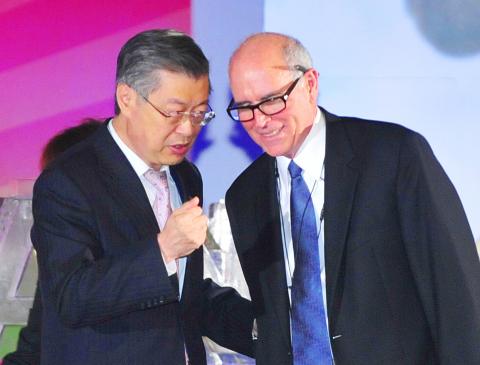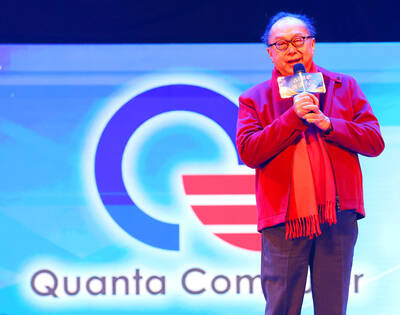“Taiwan shouldn’t be left out from the global movie production value chain,” renowned Taiwanese director Ang Lee (李安) said on Friday via a pre-recorded video to the local press.
The New York-based Lee — whose works include Sense and Sensibility, Brokeback Mountain and Crouching Tiger, Hidden Dragon (臥虎藏龍), which won an Academy Award for best foreign film in 2000 — was concerned about the future of Taiwan’s film industry and, after pulling strings for two years, persuaded US visual effects producer Rhythm & Hues Studios Inc (R&H) to set up production facilities in Taiwan.
Established in Los Angeles in 1987, R&H is one of the top-five visual effects companies in the world. It has been involved in more than 130 Hollywood films, such as The Chronicles of Narnia: The Lion, the Witch and the Wardrobe, Night at the Museum, Garfield, The Mummy and Daredevil. It received an Academy Award in 1995 for Babe and in 2008 for The Golden Compass.

Photo: Pan Shao-tang, Taipei Times
In a press conference in Taipei on Friday, R&H founder and president John Hughes told the media why the company wanted to invest in Taiwan, what the investment would entail and how Taiwan can play a role in the global movie production chain. The following is a summary of the question-and--answer session that Hughes had with reporters.
Question: R&H is planning to spend as much as NT$6 billion (US$198 million) to set up two studios and establish a movie fund. Can you tell us more about your ventures in Taiwan?
Hughes: Special thanks to director Lee for introducing us to Taiwan and the government officials here. We are going to form three companies in Taiwan.
The first will be a visual effects center, called VFX Center, where we will create visual effects and animations. We worked closely with Greater Kaohsiung Mayor Chen Chu (陳菊) and we decided to situate the VFX center in Kaohsiung. Our intention is to hire approximately 200 artists over the next couple of years and to train them to do world-quality visual effects.
The second joint venture is called CAVE, or Cloud Computing for Animation and Visual Effects, and special thanks to Taipei Mayor Hau Lung-bin (郝龍斌) and his team for helping us coordinate that. The principal partners in this joint venture are Chunghwa Telecom Co (中華電信) and Quanta Computer Inc (廣達電腦).
When you look at some of our samples, they involve an enormous amount of computer technology and computing power, bandwidth and storage. And technology is crucial in the creation of special effects. So the needs for computer technologies in the film industry are increasing exponentially and Taiwan today is one of the global centers for the design and manufacturing of computers and servers and we are very pleased and excited to partner with Chunghwa and Quanta.
When we talk about the VFX Center and CAVE, these are both parts of a process in making films. The technology, the computing and the creation of images in Hollywood are very valuable works, but they are not high up in what we call the value chain.
So the third venture is a film fund, [in] which we will be raising funds to become co-producers of movies and therefore become part of the profits participants in the films that are being made in Hollywood.
[Editor’s note: According to the Ministry of Economic Affairs, the movie fund is aimed at co-financing and co-producing major Hollywood motion pictures within the next six years by leveraging R&H’s Hollywood relationships to find investment opportunities. The movie fund will gather NT$3 billion in capital from investors and the state-managed National Development Fund will review R&H’s application for possible financial backing this month].
Question: R&H has facilities in Vancouver, Canada; Hyderabad, India; and Kuala Lumpur, Malaysia. So here comes the next question: Why Taiwan?
Hughes: From our point of view, Taiwan has a number of things that are indispensable for us to create the facilities.
The first thing we look for is the labor force, which is highly educated and competent in technology and aesthetic sense. This is because to do the kind of works that we do in animation and visual effects, it requires a person who is highly trained, well-versed in technology and in arts.
The second thing we look at is the infrastructure of the country. Without a good infrastructure, we can’t do the kind of high--technology works that we do. We look at the telecoms infrastructure, transportation facilities and reliability of electricity.
And then a very subjective criteria — the quality of life. The people at the facilities will be from Taiwan. However, the training and quality control will come from people from Los Angeles and other countries. So it is very important to ensure that the facilities are in a city where the quality of life is very high.
Through these three joint ventures, we are hoping to stimulate the digital content industry in Taiwan. We hope that others will follow us and we don’t want to be the only company here as we want to create a community of companies that does this kind of work in the digital content area in Taiwan. We were the first American visual effects company into India and afterward many other companies followed us. We hope that the same would be true here.

Intel Corp chief executive officer Lip-Bu Tan (陳立武) is expected to meet with Taiwanese suppliers next month in conjunction with the opening of the Computex Taipei trade show, supply chain sources said on Monday. The visit, the first for Tan to Taiwan since assuming his new post last month, would be aimed at enhancing Intel’s ties with suppliers in Taiwan as he attempts to help turn around the struggling US chipmaker, the sources said. Tan is to hold a banquet to celebrate Intel’s 40-year presence in Taiwan before Computex opens on May 20 and invite dozens of Taiwanese suppliers to exchange views

Application-specific integrated circuit designer Faraday Technology Corp (智原) yesterday said that although revenue this quarter would decline 30 percent from last quarter, it retained its full-year forecast of revenue growth of 100 percent. The company attributed the quarterly drop to a slowdown in customers’ production of chips using Faraday’s advanced packaging technology. The company is still confident about its revenue growth this year, given its strong “design-win” — or the projects it won to help customers design their chips, Faraday president Steve Wang (王國雍) told an online earnings conference. “The design-win this year is better than we expected. We believe we will win

Quanta Computer Inc (廣達) chairman Barry Lam (林百里) is expected to share his views about the artificial intelligence (AI) industry’s prospects during his speech at the company’s 37th anniversary ceremony, as AI servers have become a new growth engine for the equipment manufacturing service provider. Lam’s speech is much anticipated, as Quanta has risen as one of the world’s major AI server suppliers. The company reported a 30 percent year-on-year growth in consolidated revenue to NT$1.41 trillion (US$43.35 billion) last year, thanks to fast-growing demand for servers, especially those with AI capabilities. The company told investors in November last year that

Power supply and electronic components maker Delta Electronics Inc (台達電) yesterday said it plans to ship its new 1 megawatt charging systems for electric trucks and buses in the first half of next year at the earliest. The new charging piles, which deliver up to 1 megawatt of charging power, are designed for heavy-duty electric vehicles, and support a maximum current of 1,500 amperes and output of 1,250 volts, Delta said in a news release. “If everything goes smoothly, we could begin shipping those new charging systems as early as in the first half of next year,” a company official said. The new